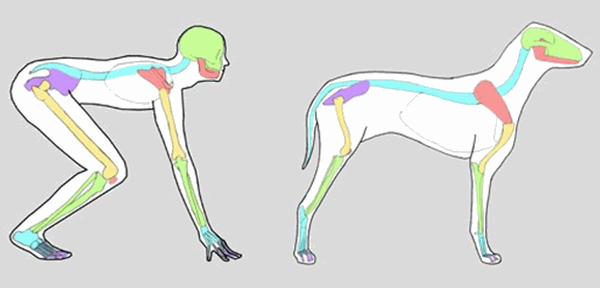What are the main functions of bones?
Bones are composed of minerals, mainly calcium and phosphorus and are vital part of the skeletal system which is the structural foundation for all vertebrates. It protects the body tissues and internal organs. Bones have been described as the scaffolding that supports all the other parts of the body.
The ribcage protects the vital organs in the chest, i.e. the heart and the lungs. The skull protects the brain and the eyes. The leg bones allow the dog to stand and move (locomotion) while the bones of the internal ear structure are for sound transmission.
So bones can have different functions but the most important ones are supporting the whole body and protect its vital organs.
How many bones make up the dog's skeleton?
Dogs have on average between 319 – 321 bones in their body. The main difference in the number of bones has to do with the tail length, i.e. shorter tails have fewer vertebrae than longer tails. Some breeds can also have extra bones in their hind dewclaws.
What is the main difference between human and canine bone structure?
Although dogs walk on four legs and we on two, their bone structure is very much the same as ours. But there are some differences.
Dogs and humans have the same bones but the size and proportion does vary. This photo highlights the similarities and differences quite well (source: Kyle Hall).

The most obvious difference is in the length of the bones in the arms and legs. Canine front legs contain the same bones as human arms and the rare legs, like the human legs, are joined to the pelvis. However, what most people consider the canine upper leg is indeed the lower leg and the lower leg is equivalent to the human palm / feet. While the dog's toes are equivalent to human fingers / toes except they are bent to reduce the impact on the bones.
Other differences include number of bones. Dogs have more bones than we humans do. They have 319 bones on average, while we have 206. Their bones are also more dense then ours.
The skull is also different. The human skull is larger to hold larger brain and it sits vertical while the dog's skull sits horizontal and protrudes out (for the nose).
How do bones and muscles function together?
There are two types of muscles in the body. Smooth muscles are found in the internal organs (stomach, bladder, intestines) and function automatically, i.e. are not subject to the dog's voluntary or conscious control. Striated muscles however are, all their movements are under the conscious control of the dog.
The striated muscles are attached to the skeleton. The muscles cause movement by pulling the bones. This movement is controlled by the brain and the nervous system, i.e. conscious control. Great deal of energy is required for muscle contraction.
What are the three dogs head shapes?
Dogs come in all shapes and sizes so it may come as a surprise that dog's heads shapes are only three:
Dolichocephalic are long and narrow heads, e.g. Collies, Afghan Hounds, Whippets, Greyhounds
Mesocephalic are heads with broader back skull than the muzzle, e.g. Golden Retrievers, Dalmatians, Beagle, Norwegian Elkhound
Brachycephalic are heads with wide skull and shortened muzzles, e.g. Pugs, Bulldogs, Pekingese

